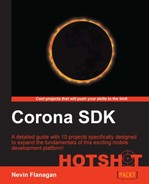The game would be singularly uninteresting if all you could do is walk around the levels and look at them.
Open world.lua, if needed, and find the function self:Add. Our first step here will be to register the world to detect taps on those objects that the player can manipulate.
Check whether the new object has an Interact function. If it does, add the world as a tap listener on the new object:
self:Place(actor, x, y) if object.Interact then actor:addEventListener('tap', self) end return actor
Next, add a tap handler to the world object:
alignBackground(self, self.Ground) end function self:tap(event) end function self:Add(object, x, y)
Because the player character represents the player in the game world, a game object can only be interacted with if the player character is next to it. The first step to determine this is to identify the tile the object is on from the event coordinates:
function self:tap(event) local x, y = self:contentToLocal(event.x, event.y) x, y = math.ceil(x / self.HSize), math.ceil(y / self.VSize) end
Next, the nearby squares are checked for the presence of at least one character (we'll write this function momentarily):
x, y = math.ceil(x / self.HSize), math.ceil(y / self.VSize) local character = seekAdjacentCharacer(self.Map, x, y) if character then end end
The object being interacted with is passed the specific character who is using it, in case it has some special effect on them:
if character then
event.target.Info:Interact(character)
endAt the top level of the file, add the function to scan adjacent squares for a character:
ground.x, ground.y = x * world.HSize, y * world.VSize end local function seekAdjacentCharacter(map, x, y) end return function (terrain, columns, rows)
This function will test adjacent offsets from the space where the object is located, starting with the space above it, until it reaches that space again:
local function seekAdjacentCharacter(map, x, y) local dX, dY = 0, -1 repeat until dY == -1 end
To advance between clockwise adjacent spaces, the loop will use a programmers' trick to swap the x and y offsets, negating the y offset to ensure that it covers all four spaces:
repeat
dX, dY = -dY, dX
until dY == -1In each space, the function will look through the local features and see if any of them is a character. If so, its work is done and it returns what it has found.
repeat local row = self.Map[y + dY] local space = row and row[x + dX] if space then for _, feature in pairs(space.Features) do if feature.Character then return feature end end end dX, dY = -dY, dX until dY == -1
Finally, we need to add a description, wherever appropriate, to objects that are interactive, so that the world knows to monitor them. The common set contains only one interactive object, the chest. Add the Interact function to the common.chest definition in objects/common.lua:
common.chest = object {
Embody = function(self)
return display.newSprite(sheet, sequences.chest)
end;
EnterSpace = false;
Interact = function (self, player)
end;
}This function will be responsible for using a function on the interacting player to give them a mark of progress toward their goal, a new item in their inventory (distinct from an item in the world):
Interact = function (self, player) if not self.Opened then self:setSequence("open") player:Give("coin") self.Opened = true end end;
